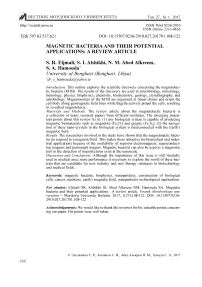Magnetic bacteria and their potential applications: a review article
Автор: Eljmali Sara Rajab, Alshikhi Salma Abrahem, Abed Alkreem Naeima Mohamed, Hamouda Samir Ahmed
Журнал: Инженерные технологии и системы @vestnik-mrsu
Рубрика: Медико-биологические науки
Статья в выпуске: 1, 2017 года.
Бесплатный доступ
Introduction. This outline explores the scientific discovery concerning the magnetotac-tic bacteria (MTB). The results of the discovery are used in microbiology, mineralogy, limnology, physics, biophysics, chemistry, biochemistry, geology, crystallography, and astrobiology. Magnetosomes of the MTB are organized in linear chains and orient the cell body along geomagnetic field lines while flagella actively propel the cells, resulting in so-called magnetotaxis. Materials and Methods. The review article about the magnetotactic bacteria is a collection of many research papers from different institutes. The emerging important points about this review lie in: (1) any biological system is capable of producing magnetic biomaterials such as magnetite (Fe3O4) and gregite (Fe3S4); (2) the navigation of these nano-crystals in the biological system is interconnected with the Earth's magnetic field. Results. The researchers involved in the study have shown that the magnetotactic bacteria do respond to a magnetic field. This makes them attractive for biomedical and industrial applications because of the availability of superior electromagnets, superconducting magnets and permanent magnet. Magnetic bacteria can also be used as a diagnostic tool in the detection of imperfections even at the nanoscale. Discussion and Conclusions. Although the importance of this issue is still limitedly used in medical area, more performance is necessary to explore the world of these bacteria that are candidate for new industry and new therapy strategies in biotechnology and medical fields.
Magnetic bacteria, biophysics, nanoparticles, construction of biological cells, cancer, medicine, earth''s magnetic field, nanoparticles technological applications
Короткий адрес: https://sciup.org/14720236
IDR: 14720236 | УДК: 597.83:537.621 | DOI: 10.15507/0236-2910.027.201701.108-122
Текст научной статьи Magnetic bacteria and their potential applications: a review article
Magnetotactic Bacteria (MTB) – magnetic microorganisms were discovered in 1963 by Salvatore Bellini in an obscure publication of the Instituto di Microbiologia at the University of Pavia, Italy. Bellini was investigating water and sediments from potholes and shallow lakes when he noticed that in many of his samples, a peculiar group of bacteria always swam in one direction, accumulat- ing on one side of the microscope slide. He also observed that some of these microorganisms, when suspended in a droplet of collected water, swam towards the arm of his microscope. Wondering if the composition of the microscope influenced this behavior, he sequentially replaced the microscope arm, lenses, and stage with metals, followed by wood and then cardboard. However, the organisms’ behaviors did not alter regardless of the changes Bellini, made for either the parts or the materials of the microscope.
Distrustful that the bacteria were being guided by an external stimulus, he attempted to manipulate them with a magnet, discovering that they immediately followed the magnet. Further experiments with both live and dead cells exhibited the same ability to follow a magnet, leading Bellini to intuition that these “magneto sensitive bacteria”, as he called them, contained an internal compass that oriented them to a magnetic field. Bellini’s findings remained largely hidden until Richard Blakemore rediscovered these magnetic bacteria in 1975. Blakemore named these bacteria “magnetotactic bacteria”, MTB an elicitation from the biological term “magneto taxis”. Blakemore described these bacteria as aquatic prokaryotes which grow at ambient and mesophilic conditions. Blakemore had spent some time investigating microorganisms living in mud, and he too realized that these cells also could be repelled or attracted to a magnet, depending on the pole that faced the cells [1–2].
The discovery of MTB caused a significant impact on research fields such as microbiology, physics, biophysics, chemistry, biochemistry, geology, limnology, crystallography, and even in astrobiology. This strange behavior attracted a great deal of interest from other scientists, bringing magnetic bacteria into laboratories as a research specimen. Although magnetic bacteria can be found in any environment, especially in lake and seawater habitats, due to their unique life, it is not easy to isolate and cultivate MTB. However, the fast advances in biotechnology, magneto technology and in other fields have eased the cultivation of MTB in laboratories.
The formation and physiological function of magnetic crystals in these organisms are still not known sufficiently. However, thorough understanding of bacterial magnetosome formation will serve as a model to uncover the mechanism of magnetosome formation and function in other species. It is also noted that functional analysis of several genes involved in magnetosome formation, such as, mamJ, mamK, magA have revealed the roles of membrane associated proteins in transport and bio mineralization. Current research at present time focuses on the molecular mechanisms of bacterial magnetosome formation and its practical applications in biotechnology and medicine.
However, two developments during the past decade have changed this perception dramatically, the first being the discovery that many organisms, including bees, algae, pigeons, and humans, are also capable of biochemically precipitate the ferrimagnetic mineral magnetite (Fe3O4). In the MTB, the geomagnetic response is based on either biogenic magnetite or greigite (Fe3S4). Second, the development of simple behavioral conditioning experiments for training honey bees to discriminate magnetic fields demonstrates conclusively that at least one terrestrial animal is capable of detecting earth-strength magnetic fields through a sensory process [3].
Materials and Methods
Magnetosome formation is the mineralization process under strict biochemical mechanisms control, including four steps: iron accumulation, membrane formation, transportation and controlled bio mineralization of magnetite (Fe3O4). Magnetite contains both ferrous (reduced) and ferric (oxidized) iron species. Magnetite is oftentimes described as iron II,III oxide. Fe ions exist in both the +2 and +3 valence states. Equation1. Shows an oversimplified synthesis reaction demonstrates the chemical makeup of the compound [4].
FeO (Ferrous Oxide) +
+ F2O3 (Ferric Oxide) → F3O4 (Magnetite). (1)
The formation mechanism of magnetosomes is a complex process and is not entirely understood. It includes the formation of magnetosome vesicles, taking the iron mineral into the cell, carrying the iron in the magnetosome vesicles and the control of magnetite or greigite biomineralisation within the vesicle. However, there are some other views that explain the process. In these views, it was proposed that three major steps were present in magnetosome biomineralisation. The first step involves the cytoplasm folding inwards, creating a pocket to form the magnetosome membrane by GTPase, and the organization of these vesicles along a line to form the magnetosomes’ carrier fiber. The second step is involving the carrying of iron into the cell by carrier proteins and siderophores and collecting them in the vesicles by transmembrane iron carriers. The iron within the cell is strictly controlled by oxidation and reduction mechanisms, as too much iron is highly dangerous for the cell. The last step is the formation of magnetite in the magnetosome and the organization of the morphology.
In MTB, magnetite formation takes place in microaerobic and anaerobic conditions, as high oxygen content has an inhibiting effect. However, the relation between magnetite formation and low oxygen levels are unclear. While the relation between magnetosome formation and sources of iron is unclear, it is known that iron is the basic element for magnetosome production. MTB require more iron compared to other bacteria for the biomineralisation of the magnetite crystal.
Magnetite (Fe3O4) is the main chemical component of magnetosomes characterized by the high chemical purity, fine grain size uniformity, and good biocompatibility. These properties can be used as a new kind of nano-magnetic materials applied in many fields of biochemistry, magnetic materials, clinical medicine and wastewater treatment [5]. The various types of (F3O4) and (F3S4) magnetosome crystal morphologies are shown in fig.1.
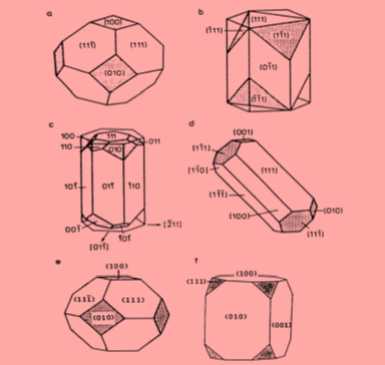
F i g. 1. a–d) Fe3O4; a: cubo-octahedron (equilibrium form); b–c) hexahedral prisms; d) elongated cubo-octahedron; e-f) Fe3S4; a) cubooctahedron (equilibrium form); b) rectangular prismatic crystal [6]
Р и с. 1. а–d) Fe3O4; а) кубо-октаэдр (равновесная форма); b–c) шестигранные призмы; d) удлиненный кубо-октаэдр; е-f) Fe3S4; а) кубо-октаэдр (равновесная форма); b) прямоугольный призматический кристалл [6]
MTB produce crystals that are the smallest crystals that can be formed of (Fe3O4) or (Fe3S4) and still be permanently magnetic at ambient temperature. Figure 2 describes the magnetic domains for the magnetosomes. Magnetosomes contain crystals that are Stable Single-Magnetic-Domains.
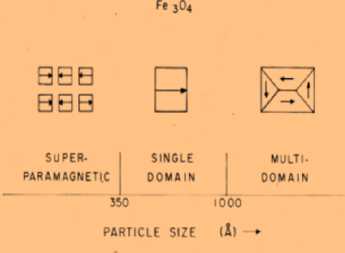
F i g. 2. Magnetosomes contain crystals that are Stable Single-Magnetic-Dom ains [6].
Р и с. 2. Магнитосомы содержат кристаллы, являющиеся стабильными отдельными магнитными доменами [6]
Magnetotactic bacteria arrange their Magnetosomes in chain(s) along long axis of cell. These bacteria have a unique feature of consuming soluble salts of iron from growth media to form intracellular chains of single magnetic crystals (30–40 nm) of magnetite (Fe3O4) and gregite (Fe3S4). These intracellular nano-crystals, each encapsulated by its own biological membrane about 3–4 nm thick are known as magnetosomes. Magnetosomes are organized in linear chains and orient the cell body along geomagnetic field fig. 3. Shows the arrangement of magnetosomes surrounding a biological cell. However, the magnetosome proteins such as MamK and MreB play an essential role in the Construction of the Magnetosome Chain (fig. 4.) [6].

F i g. 3. Magnetospirillum magneticum with single magnetosome chain.
The magnetosome chain acts like a single magnetic dipole [14]
Р и с. 3. Magnetospirillum magneticum с одной магнитосомной цепью. Магнитосомные цепи действуют как единый магнитный диполь [14]
The magnetosome chain acts like a single magnetic dipole. In the chain motif, the total cell magnetic dipole moment is the sum of that of the individual crystals. This implies that by forming chains, the bacterium has maximized its magnetic dipole moment (remanence). Magnetosomes are vesicles that are in a membrane within the cytoplasm that is full of magnetite and greigite, which help the bacteria align themselves according to the Earth’s magnetic field [6].
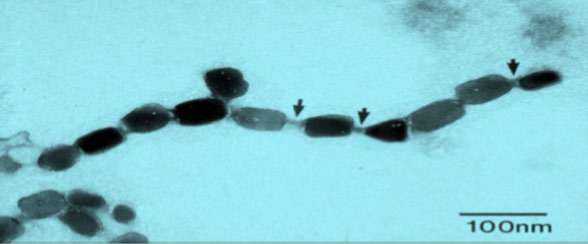
F i g. 4. Purified magnetosomes with membranes. Magnetosome membranes contain unique proteins which are involved in construction of the magneto-some chain [6]
Р и с. 4. Магнитосомные белки играют важную роль в построении магнитосомной цепи [6]
It can be added that current research have revealed the same features that are shared by the magnetite crystals extracted 112
from magnetotactic bacteria and by some of those extracted recently from the soft tissues of the human brain (fig. 5).
Медико-биологические науки
BACTERIA
HUMAN
(Aquaspirillum magnetotacticurn) (Homo sapiens)
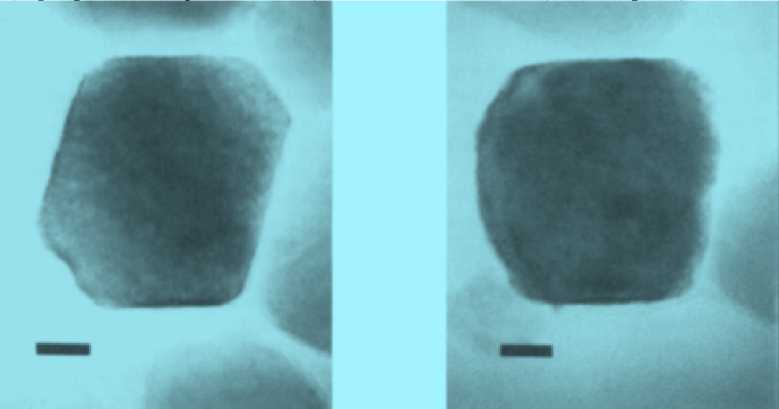
F i g. 5. Shows a comparison of high-resolution (HR) TEM images of singlc-domain magnetite extracted from the magnetotactic bacterium. Aquaspirillum Magnetotacticum and from the human cerebellum [7]
Р и с. 5. Сравнение изображений, полученных с помощью просвечивающего электронного микроскопа (ПЭМ), однодоменного магнетита, извлеченного из магнитотактической бактерии Aquaspirillum magnetotacticum и из человеческого мозжечка [7]
Magnetite crystals formed within these magnetosome vessicles have three main features which serve to distinguish them from magnetites formed through geological processes. First, high-resolution TEM studies reveal that bacterial magnetites are nearly perfect crystals, usually elongate in the [111] direction. Inorganic magnetites are usually small octahedral crystals, often with lattice dislocations and other crystal defects. The elongation of biogenic crystals in the [111] direction serves to maximize the net magnetic moment of the particle, and presumably is the result of natural selection for their magnetic properties. Second, bacterial magnetite crystals are restricted to a size range from 30 to about 500 nm, with shapes which confine them to the singledomain magnetic stability field . Inorganic magnetites tend to have log-normal size distributions, and range from superMedical and biological sciences paramagnetic to multi-domain in size. Third, bacterial magnetites tend to be rather pure iron oxide, with no detectable concentrations of the element titanium which is typically present in geologically produced magnetite.
It can be concluded that many higher organisms including humans possess the biochemical ability to form magnetite. The knowledge of the biological functions of magnetite are as yet incomplete. Magnetite is the hardest known biogenic material formed by an organism. Magnetite also seems to be involved in the ability of many animals to use the geomagnetic field as an orientational or navigational cue. The magnetosome chains in the salmon, which strongly resemble those in the bacteria and algae, could certainly be used for this purpose. Recent behavioral work with honeybees, showing that north-seeking bees can be changed 113
into south-seekers with a brief magnetic pulse, confirms that a ferromagnetic material like magnetite is indeed part of the honeybee magnetic sensory system [7].
However, Magnetite is now known to form commonly in a variety of tissues for which a sensory function is rather unlikely because magnetite was also found in human and mouse tumors. Biogenic magnetite has been found in many organisms ranging from bacteria to higher vertebrates, including humans. The high levels of magnetite in rapidly growing mouse tumors hints that it may have a role in cell division. This implies that magnetite has as yet unknown roles in eukaryotic biochemistry, perhaps as a localized source of iron for activating iron-based enzymes [7]. It is also present in many tumor materials. The physical properties of magnetite are shown in table.
Т а б л и ц а
|
Some Physical Properties of magnetite Некоторые физические свойства магнетита |
T a b l e |
|
Magnetite melting / Температура плавления |
1 590 °C |
|
Boiling points are observed / Наблюдаемая точка кипения |
2 623 °C |
|
Density / Плотность |
5.18 g/cm3 |
|
Heats of fusion (at 2 623 °C) / Теплота плавления при 2 623 °C |
138.16 kJ/mol |
|
Decomposition (at 2 623 °C) / Энергия разложения при 2 623 °C |
605.0 kJ/mol |
|
Vaporization (at 2 623 °C) / Энергия парообразования при 2 623 °C |
298.0 kJ/mol |
|
Curie temperature / Точка Кюри |
850 K |
|
Enthalpy / Энтальпия |
1 115.7 kJ/mol |
|
Entropy of formation / Энтропия образования |
146.1 kJ/mol/K |
|
Magnetite particles are not porous / Частицы магнетита не пористы |
|
|
Dissolution is much faster than other pure ferric oxides / Растворение происходит гораздо быстрее по сравнению с другими чистыми оксидами железа |
|
Magnetotactic bacteria are obligate micro-aerophiles and need narrow range of dissolve oxygen for growth as well as magnetosome formation. For producing magnetosomes from magnetotactic bacteria, oxygen and its concentration are crucial. Many are microaerophilic, meaning that they prefer low oxygen levels for growth. Despite the diversity in these crystals (see fig. 6), they also exhibit motility, directed by the earth’s geomagnetic field to swim either up or down in water, presumably to reach regions where oxygen levels are optimal., however, the magnetosomes’ ability to interact with magnetic fields and their miniscule size makes them nanoparticles with many potential applications.
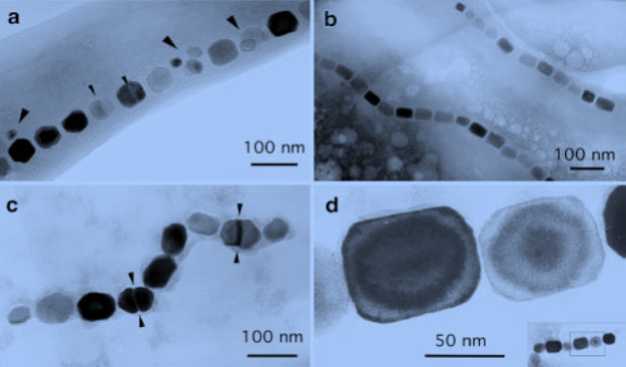
F i g. 6. TEM micrographs of chains of magnetosomes, showing various morphologies: a) cubic twinned crystals (small arrows), and clusters of small crystals (large arrows) mag-netotacticum; b) rectangular crystals in strain; c) elongated crystals, characteristic of twinning (arrowed); d) rectangular crystals with thickness fringes in strain [8]
Р и с. 6. Микрофотографии цепей магнитосом, полученные с помощью просвечивающего электронного микроскопа (ПЭМ), показывают различную морфологию: a) кубические спаренные кристаллы (маленькие стрелки), и кластеры мелких кристаллов (большие стрелки) бактерий М. magnetotacticum ; b) прямоугольные кристаллы; с) вытянутая форма кристаллов, характерная для спаренных кристалов (показаны стрелками); d) прямоугольные кристаллы со слоем окантовки [8]
Results
Magnetism is the phenomenon by which some materials attract or repel other materials from a distance. Examples of such materials include iron, lodestone and some steels. Magnetic forces are generated by moving charged particles, leading to magnetic fields. If a material is placed in an external magnetic field, the atoms in this material possess an atomic moment which responds to this external field (see fig. 7). Magnetic materials also possess magnetic dipoles. These dipoles can be considered to be small bar magnets with north and south poles. The magnetic dipole moment can respond to the external magnetic field.
The external magnetic field strength is denoted by H (units A/m), the magnetic induction in the material is denoted by B (units tesla) and the magnetization by M (units A/m). B, H and M are related by:
B = μ0 (H +M), (2)
where μ0 is the permeability of free space (its magnitude is 1.257 × 10-6 H/m) and M is the magnetic moment m per unit volume of the material . The value of M depends on the type of material and the temperature and can be related to the field H through the volumetric magnetic susceptibility χ by the relation:
M = χH. (3)
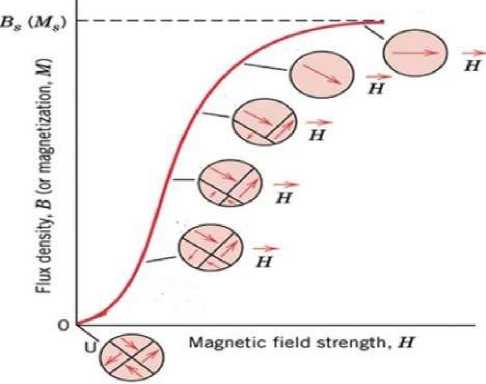
н = о
F i g. 7. The B-versus-H behavior for a ferromagnetic material that was initially unmagnetized [9]
Р и с. 7. Соотношение между плотностью потока (В) и силой магнитного поля (Н) для ферромагнитного материала, который не был первоначально намагничен [9]
The magnetic response results in materials being classified as either diamagnetic (repelled weakly from a magnetic field, as is water and almost any fatty substance). Paramagnetic (weakly at- tracted to a magnetic field, as is deoxyhemoglobin in blood cells fig. 8). Shows the magnetic dipoles configuration for a diamagnetic and paramagnetic material with and without a magnetic field.
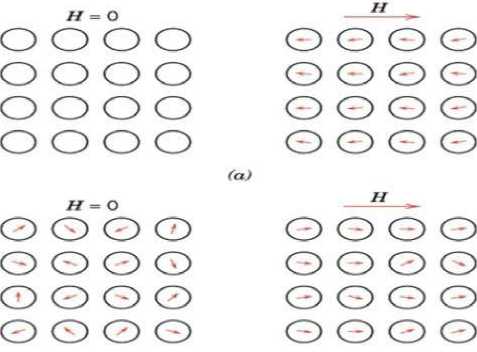
<ь>
F i g. 8. a) The magnetic dipole configuration for a diamagnetic material with and without a magnetic field. In the absence of an external field, no dipoles exist; in the presence of a field, dipoles are induced that are aligned opposite to the field direction; b) magnetic dipole configuration with and without an external magnetic field for a paramagnetic material [9]
Р и с. 8. а) Магнитная конфигурация диполя для диамагнитного материала при наложении и без наложения магнитного поля. При отсутствии внешнего поля не диполя существует; при наложении поля диполи индуцируются и выравниваются противоположно направлению поля; b) магнитная конфигурация диполя при наличии и отсутствии внешнего магнитного поля для парамагнитного материала [9]
116 Медико-биологические науки
Ferromagnetic (interact very strongly with the magnetic field) (see fig. 9.).
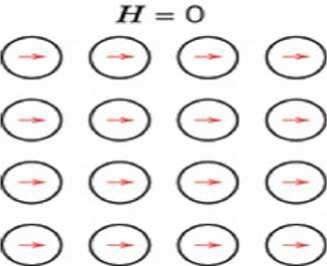
F i g. 9. Schematic illustration of the mutual alignment of magnetic dipoles for a ferromagnetic material, which will exist even in the absence of an external magnetic field [9]
Р и с. 9. Схематическая иллюстрация взаимного расположения магнитных диполей для ферромагнитного материала, который будет существовать даже при отсутствии внешнего магнитного поля [9]
Antiferromagnetism and ferrimagnetism fall within the broad category of ferromagnetism. Some materials, including the magnetic biomaterial magnetite (Fe3O4), exhibit ferrimagnetic behavior. In the case of Fe3O4, Fe ions exist in both the +2 and +3 valence states. The magnetic moments of the two types of Fe ions differ; in this case, there is a net
magnetic moment because for the solid as a whole the spin moments are not completely cancelled.
The Earth can be considered as a large magnet surrounded by a magnetic field. It is thought that the Earth’s magnetic field is caused by convection flows (vertical movement caused by the temperature differences in the inner and outer layer) in the liquid crust. The outer core is the area between the inner core and the mantle, which is 1 260 km thick and is made of iron and nickel. While the temperature in the outer parts of the outer mantle is 4 400 ºC, the temperature goes up to 6 100 ºC in the parts close to the inner core. The regular displace- ment of the atoms in a sufficient power causes the forming of magnetic fields and this causes a permanent magnetism around the Earth. It is also thought that the eddy flows in liquid iron and nickel affects the Earth’s magnetic field. However, there is an 11º difference between the Earth’s rotation axis and the dipole magnet’s rotation. The Earth’s magnetic field is about 5×10-5 T.
The Earth’s magnetic field is like a dipole magnet that has north and south poles (see fig. 10.). The earth is pictured as a large magnet, a dipole with the positive pole at the south pole and a negative pole at the noth pole. Field lines from outside the earth connecting from the south (+) pole to the north (-) pole. In the northern hemisphere, the field lines are oriented downward into the earth, and vice-versa in the southern hemisphere.
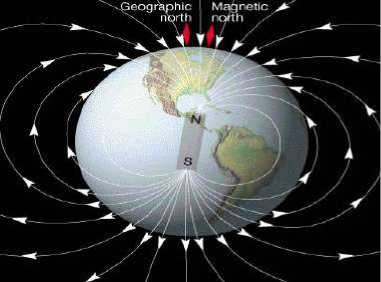
F i g.10. Magnetic field lines of a bar magnet.
An ideal shape for the magnetic field close to the surface of Earth planet, as produced inside this body by fluid motions
Р и с. 10. Магнитные силовые линии магнитного стержня. Идеальная форма магнитного поля Земли, образованная токами в жидком металлическом ядре планеты
Like most other free-swimming bacteria, magnetotactic bacteria propel themselves through the water by rotating their helical flagella. Because of their magnetosomes, magnetotactic bacteria are passively oriented and actively migrate along the local magnetic field B, which in natural environments is the geomagnetic field. The original model for the function of magnetotaxis was based on the assumption that all magnetotactic bacteria are micro-aerophilic and indigenous in sediments.
The geomagnetic field is inclined downward from horizontal in the Northern Hemisphere and upward in the Southern hemisphere, with the inclination magnitude increasing from the equator to the poles. NS Cells which swim northward in the Northern hemisphere and SS cells which swim southward in the Southern hemisphere would migrate downward towards the sediments along the inclined geomagnetic field lines. Thus magnetotaxis helps to guide cells in each hemisphere downward to less oxygenated regions of aquatic habitats. Once cells have reached their preferred microhabitat they would presumably stop swimming and adhere to sediment particles until conditions changed, as for example, when additional oxygen was introduced, or when disturbance of the sediments caused them to be displaced into the water column.
This theory is supported by the predominant occurrence of North-seeking (NS) magnetotactic bacteria in the Northern hemisphere and South-seeking (SS) magnetotactic bacteria in the Southern hemisphere, as determined by the magnetotaxis assay under oxic conditions. Due to the negative and positive sign of the geomagnetic field inclination in the Northern and Southern hemispheres, respectively, magnetotactic bacteria in both hemispheres therefore swim downward toward the sediments under oxic conditions [10].
It is a known fact how the magnetic field of the Earth is very important for life on Earth. Relation between living systems and the earth magnetic field has been investigated for many years. The Earth’s magnetic field is still accepted to be the main factor for birds and other flying living beings to complete their travels correctly. The changes in migration routes, which are observed from time to time, are sometimes said to be due to the changes in the Earth’s magnetic field. However, the Earth’s magnetic field has not been sufficiently studied, and its role on small living models such as bacteria has not been adequately discussed.
One of the best examples in this field is the relation between the Earth’s magnetic field and magnetotactic bacteria which were discovered by Salvatore Bellini in 1963. Most materials found in organisms are generally thought of as being nonmagnetic, either diamagnetic or paramagnetic. For materials of these types, the direct physical influence of the earth’s magnetic field is extraordinarily weak with the energy of magnetic interaction being many orders of magnitude below that of the background thermal energy, kT (where k is the Boltzmann constant and T the absolute temperature) [11].
However, another category of materials, termed ferromagnetic, interact very strongly with the earth’s magnetic field. Unlike diamagnetic and paramagnetic substances, quantum-mechanical interactions acting on unpaired electrons within ferromagnetic materials force the electron magnetic moments (Bohrmagnetons) to form long-range alignments. The magnetic moment from each Bohr magneton within such a crystal is added vectorially, and in some materials a crystal of only a few tens of nanometers in size will have magnetic interaction energies with the 50 microtesla (μT) geomagnetic field in excess of the background thermal energy.
Motion of this material in response to external magnetic fields can in principle account for a variety of magnetic effects at the cellular level, such as the magnetic alignment of magnetotactic bacteria and algae. Under some conditions the induced motions of magnetosomes can be large enough to open mechanically sensitive transmembrane ion channels, which in turn have the potential to influence a wide range of cellular processes.
At present, 12 iron minerals have been identified in organisms although only two of these (Fe3O4, Fe3S4) have been found so far as biochemical precipitates in vertebrates. Of these materials, magnetite has a variety of ferromagnetism termed ferrimagnetism. These properties make magnetite interact over 106 times more strongly with external magnetic fields than does any other biological material. Magnetite is the first novel material to be discovered as a biochemical precipitate in human tissues through the medical science and everything else in human bones and soft tissue is either diamagnetic or paramagnetic. Magnetite is also the only known metallic compound to be made by living organisms and has the highest electrical conductivity of any cellular material. Although the total amount of magnetite in an adult human is small (a few hundred micrograms), there are several million crystals per gram, each of which interact rather strongly with external magnetic fields. Because magnetite is the only known biogenic mineral in higher organisms which is ferromagnetic at room temperature, it is important for human health to know what is the biological function of this material in human tissues and how it forms [7].
Many of the effects reported in bio-magnetic experiments suggest that the magnetic field acts somehow to alter the electrical properties of biological membranes. In order to understand this interaction, it would be worth viewing Maxwell-Boltzmann distribution. Maxwell-Boltzmann distribution states that the probability f(E) that a particle will have energy E is given by:
f(ΔE) = A exp (-ΔE/kT), (4)
where A is normalization constant. e the probability for occupying a given energy state decreases exponentially with energy. K is Boltzmann’s constant times the absolute temperature T. the application of this term is that for a higher temperature, it is more probable that a given particle can be found with energy ΔE.
One of several possible mechanisms for producing dramatic biological effects from
MORDOVIA UNIVERSITY BULLETIN wjl mechanical motions within a cell is the opening and closing of mechanically sensitive trans-membrane ion channels. These structures operate essentially at the kT limit, and external input of mechanical energy of ΔE will change the probability of a channel being open or closed by a Boltzmann factor of exp(-ΔE/kT). If coupled perfectly, a magnetosome with a magnetic thermal energy ratio of 10 in the geomagnetic field could act to change the probability of a gate being closed by a factor of exp(-10) (e.g., the probability at any time of the gate being closed could shift from a value near 0 .99999 to a value of 0.00005).
On the other hand, acquired knowledge have indicated that magnetosomes are unequivocally responsible for the magnetotactic response of microorganisms. Mutants of magnetotactic bacteria have been obtained which do not synthesize magnetosomes. These are fully motile but not magnetotactic. With both bacteria and algae, the arrangement and volume of magnetite present within each cell is more than enough to align it passively in the Earth’s field of 5x10-5T. The ratio of magnetic to thermal energy (-μB/kT) is greater than 10 for the bacteria and greater than 100 for the algae. Thus, each cell’s magnetic moment easily overrides the effect of Brownian motion caused by thermal agitation which tends to randomize cell orientation.
There are two basic types of motions that external magnetic fields might produce on an intracellular magneto-some: a translational force on the particle produced by gradients in the field, and a rotational torque generated as a particle tries to line up like a compass with the applied field. The translational force for a sub-micron magnetite particle is well below thermal noise in virtually all situations encountered by human; Moreover, the ability to re-magnetize the cells by means of a brief, monophasic magnetic pulse of several hundred teslas and thereby instantaneously reverse their swimming direction without cell turning provided unequivocal proof that the magnetotactic behavior of these organisms is due to ferromagnetism [7].
Discussion and Conclusions
Magnetism and magnetic materials have been used for many decades in many modern medical applications. Several new applications are being developed in part because of the availability of superior electromagnets, superconducting magnets and permanent magnet. Magnetic materials can be applied to cell separation, immunoassay, magnetic resonance imaging (MRI), drug and gene delivery, minimally invasive surgery, radionuclide therapy, hyperthermia and artificial muscle applications.
Current research areas in medicine to which magnetic biomaterials can be applied include molecular and cell biology, cardiology, neurosurgery, oncology and radiology. The physical properties which make magnetic materials attractive for biomedical applications are: (1) they can be manipulated by an external magnetic field. This feature is useful for separation, immunoassay and drug targeting, and (2) hysteresis and other losses occur in alternating magnetic fields. This is useful in hyperthermia applications.
Nanoparticles made from magnetic materials are referred to as “magnetic nanoparticles”. These particles can be moved by applying magnetic fields, which allows them to be controlled inside the body. Magnetic nanoparticles suspended in solution are called “ferrofluids” and have many applications in medicine, acoustics, and electronics. There are two ways that magnetotactic bacteria might be useful. One approach takes advantage of the cells’ abilities to align to a magnetic field. A second approach would be to extract the magnetosomes from the bacteria to use as small, uniformly sized magnets in devices that require such nanoscale particles. In the human body, there is a constant movement of ions within and outside the cells as well as across cellular membranes. This electrical activity is responsible for magnetic fields, called bio-magnetic fields. In order to study and use these magnetosomes, scientists must be able to grow these magnetosome containing bacteria in a reliable fashion.
In biology, there has been much interest in the possible use by bees and pigeons of magnetic materials as biological compasses for navigation. Some magnetotactic bacteria are known to respond to a magnetic field, they contain chains of small magnetite particles and they can navigate to the surface or bottom of the pools that they live in using these particles. These particles can be obtained by disruption of the cell wall followed by magnetic separation; the presence of the lipid layer makes these particles biocompatible and they can be readily functionalized for a variety of biomedical applications. The benefit of using biologically-derived nanomagnets made of iron oxides, like magnetosomes, is that they can be taken up by the body with minimal toxic side effects.
One consideration for these magnetic nanoparticles is in cancer treatments. In one type of treatment, magnetic particles are used to generate heat and kill cancerous cells in a technique known as magnetic hyperthermia. Magnetic particles can either be injected locally into the cancerous tissue or by using antibodies tagged with these magnetic particles that attach to cancerous tissues. Then, the magnets can be turned in a magnetic field to generate heat, effectively destroying the cancerous cells. Currently, clinical and research studies are being performed using magnetosomes of different sizes and shapes to determine the most optimal particles that will efficiently conduct magnetic hyperthermia. This research takes advantage of the wide range of shapes and sizes of magnetosomes produced in magnetic bacteria.
Another medical application of magnetosomes is to use them for drug delivery, which is the transportation of drug molecules to specific regions of the body. The advantage of using magnetosomes for drug delivery in the body, rather than other methods, is the ability to control and direct their path to- wards particular tissues that require treatment through a magnetic field treatment and minimize the impact of chemotherapy drugs on surrounding cells. The same technique could be used to carry anti-inflammatory, anti-bacterial, or blood clotting drugs to localized regions. Another valuable application would be the use of magnetosomes as contrast agents in magnetic resonance imaging (MRI).
In industry, industrial production requires the use of toxic or heavy metals, which are often difficult to handle. Since magnetotactic bacteria can be easily manipulated by the turn of a magnet, the entire cells themselves would be useful as microscopic “shovels” or “carpets” with which to move layers of substances. For example, when bacteria are grown in media, or food sources, containing certain metals and minerals, the metals are taken up by the bacteria. In this way, certain metals can be accumulated in the bacteria. Then the bacteria can be drawn away from the remaining mixture by applying a magnetic field. This technique would effectively remove chemicals from a mixture. In addition, bacteria can be attached to larger particles that need to be separated or isolated but cannot be taken up inside the bacteria. This technique of fixing bacteria to these particles could be useful for removing the particles, as one could then direct the bacteria and their attached cargo to swim in a certain direction along a magnetic field to a separate area [4; 12–13].
This review article about Magnetic Bacteria is a collection of many research papers from different institutes. The emerging important points about this review lie in: (1) any biological system is capable of producing magnetic biomaterials such as magnetite (Fe3O4) and gregite (Fe3S4). These intracellular nano-crystals are termed magnetosome. Owing to the numerous proteins that are present in the magnetosome membrane and the lack of information about their function, it is expected to see many studies focused on the characterization of these proteins, as well as site-directed mutagenesis studies to determine the role of these proteins in magnetite synthesis. (2) the navigation of these nano-crystals in the biological system is interconnected with the Earth’s magnetic field.
In addition, researchers involved in the study of magnetotactic bacteria have shown that magnetotactic bacteria do respond to a magnetic field. This makes them attractive for biomedical and industrial applications because of the availability of superior electromagnets, superconducting magnets and permanent magnet. Magnetic bacteria can also be used as a diagnostic tool in the detection of imperfections even at the Nanoscale. Although the importance of this issue is still limitedly used in medical area, more performance is necessary to explore the world of these bacteria that are candidate for new industry and new therapy strategies in the medical field.
Список литературы Magnetic bacteria and their potential applications: a review article
- Low E. Magnetic bacteria: A future in industry and medicine. Berkeley Scientific Journal. 2011; 14(2). Available from: http://escholarship.org/uc/item/1n3575xm
- Naresh M, Das S, Mishra P, Mittal A. The chemical formula of a magnetotactic bacterium. Biotechnology and Bioengineering. 2012; 5(109):1205. Available from: http://web.iitd.ac.in/~amittal/2012_Nar-esh_etal_Biotechnol_Bioeng.pdf
- Blakemore R. Magnetic bacteria. Science: New Series. 1975; 190(4212):377-379. Available from: http://www.calpoly.edu/~rfrankel/RPBScience75.pdf
- Blaney L. Magnetite (Fe3O4): Properties, synthesis, and applications. Lehigh review. 2007; 5(15):33-81. Available from: http://preserve.lehigh.edu/cas-lehighreview-vol-15/5
- Bazylinski DA, Frankel RB. Magnetosome formation in prokaryotes. Nature reviews. Microbiology. 2004; 2:217-230. Available from: http://www.calpoly.edu/~rfrankel/NatRevMicro.pdf
- Bazylinski DA. Small magnetism, big attraction: the magnetotactic bacteria. Available from: http://www.irm.umn.edu/SantaFe9/Bazylinski_SF9.pdf
- Kirschvink JL, Kobayashi-Kirschvink A, Diaz-Ricci JC, Kirschvink JS. Magnetite in human tissues: a mechanism for the biological effects of weak ELF magnetic fields. Bioelectromagnetics Supplement. 1992; 1:101-113. Available from: http://web.gps.caltech.edu/~jkirschvink/pdfs/KirschvinkBEMS92.pdf
- Devouard B, Posfai M, Hua X, Bazylinski DA, Frankel RB, Buseck PR. Magnetite from magnetotactic bacteria: Size distributions and twinning. American Mineralogist. 1998; 83(11-12, part 2):1387-1398. Available from: http://minsocam.org/MSA/ammin/toc/Articles_Free/1998/Devouard_p1387-1398_98.pdf
- Magnetism. California State University, Northridge, Magnetism MSE 630. 2008. Available from: http://www.freeppt.website/free-ppt/magnetism-ppt.html#
- Bazylinski DA, Frankel RB. Magnetotaxis in bacteria. Available from: http://www.calpoly. edu/~rfrankel/magbac101.html
- Dasdag S, Bektas H. Magnetotactic bacteria and their application in medicine. J. Phys. Chem. Biophys. 2014; 2(4): DOI: 10.4172/2161-0398.1000141
- Siores E, Lamb AS, Swallow LM. Bacterial magnetic particles for potential applications in na-noscale NDT&E. 4th International Conference on NDT, Hellenic Society for NDT. Chania, Crete, Greece. 2007. Available from: http://www.ndt.net/article/hsndt2007/files/Siores.pdf
- Blakemore RP, Blakemore NA, Frankel RB. Bacterial biomagnetism and geomagnetic field detection by organisms. Available from: http://andrewamarino.com/PDFs/MB/MB_Ch02.pdf
- Bolender R. Magnetosirillum magneticum genes MamB and MamM and a possible agent for bioremediation. Available from: http://digitalcommons.colby.edu/cgi/viewcontent.cgi?params=/context/clas/article/1813/type/native/&path_info=

